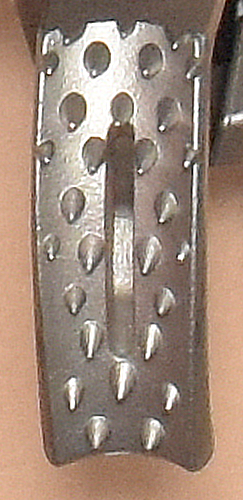Technical Details
 I acquired my Skylotec Get Up from Safe Rescue LLC in 2021.
I acquired my Skylotec Get Up from Safe Rescue LLC in 2021.
The Skylotec Get Up is a right-handed ascender. It is 95 mm. tall, 65 mm. wide, 38 mm. thick, and weighs 125 g. The ascender shell
is an irregular anodized shape stamped from 3.4 mm.
aluminum sheet. The rope channel is formed by bending the left
side of the ascender into a U. The rope channel is 15 mm.
wide. The main sling attachment point is a 17 mm. wide, 23 mm. tall Г-shaped hole in a clevis riveted to a shell extension located below the cam near the rope channel. There are two 19 by 15 mm. pear-shaped holes near the top of the the rope
channel U. The right end of the shell is
bent on an inclined axis to form another U. A hole drilled through
both sides of the U accepts a semi-tubular rivet. The cam and cam spring
are mounted on this rivet. The rivet is centered 48 mm. from the inside
of the rope groove.
The drooped cam is a steel casting. The cam radius, measured from the pivot, increases from 34 to 49 mm.
over an angle of 39°, giving a 27° cam angle. The tooth pattern is (3.4.3)(2S2.1S1)^2(1S1)(3.2). A spring-loaded
manual safety bar is mounted on the bottom of the cam with a split pin. The normal action of
the spring holds the safety against the cam. When the cam is opened,
the shell interferes with the safety bar, thus preventing opening
the cam. If the safety bar is moved away from the cam (opposing
the spring), it will clear the shell and the cam will open. At
full open the safety can be released and the spring will hold
the safety against the back of the shell. A plastic-covered cable with a knob on the end is attached to the safety tab to assist in operating
the safety mechanism.
The front of the rope channel is printed with "TOP," "↑," "GET UP" and "H-201." The inside of the shell is printed with a scanner code, a factory icon, "09/2020", "(293020) 050," and the Skylotec logo. The rear is printed with the Skylotec logo, "Skylotec," the UIAA logo, "UIAA," "EN 567/2013," "Ø 8-13mm," "EN12841-B:2006," "1 9-13 mm.," "140 kg," a book-with-an-"i" icon, "CE0123," "Im Mühlengrund 6-8," and "D-25266 Neuwled."
The Get Up is a nicely-made ascender. It offers some interesting variations on the classic hand ascender design, showing that Skylotec is willing to innovate.
The first and most obvious variation is the orange clevis below the shell. The Skylotec manual says that the "90° rotated lower attachment hole enable[es] cleaner interacting with the chest ascender during rope ascent." Their instructions show the Get Up used as part of a Frog System. I like using a handleless ascender as the upper ascender in a Frog System, and I don't notice any unclean interactions with the chest ascender, finding that the tie-in knot separates the two. In this respect, the Skylotec design appears to be a solution looking for a problem. On the plus side, the clevis gives a larger-radius surface for the slings to run over. On the minus side, the clevis lengthens the ascender unnecessarily, adding about 45 mm. to how high one has to hold their hands. It is not a lot, but it is noticeable.
The second variation is the cable on the cam safety. I find the Get Up can easily be opened with one hand using the safety tab, so I don't see a need for the cable.
Overall, I see nothing "wrong" with the innovations, aside from the length added by the clevis, but they don't seem to be necessary. If they were, everyone would have had them ages ago, but until we try new ideas, we should not dismiss them.


